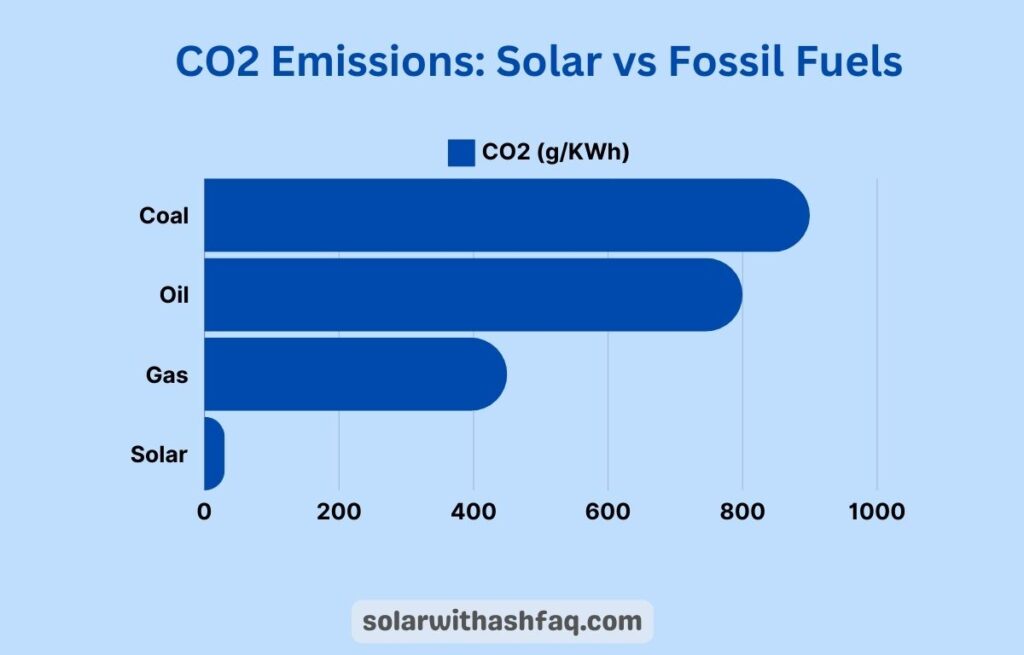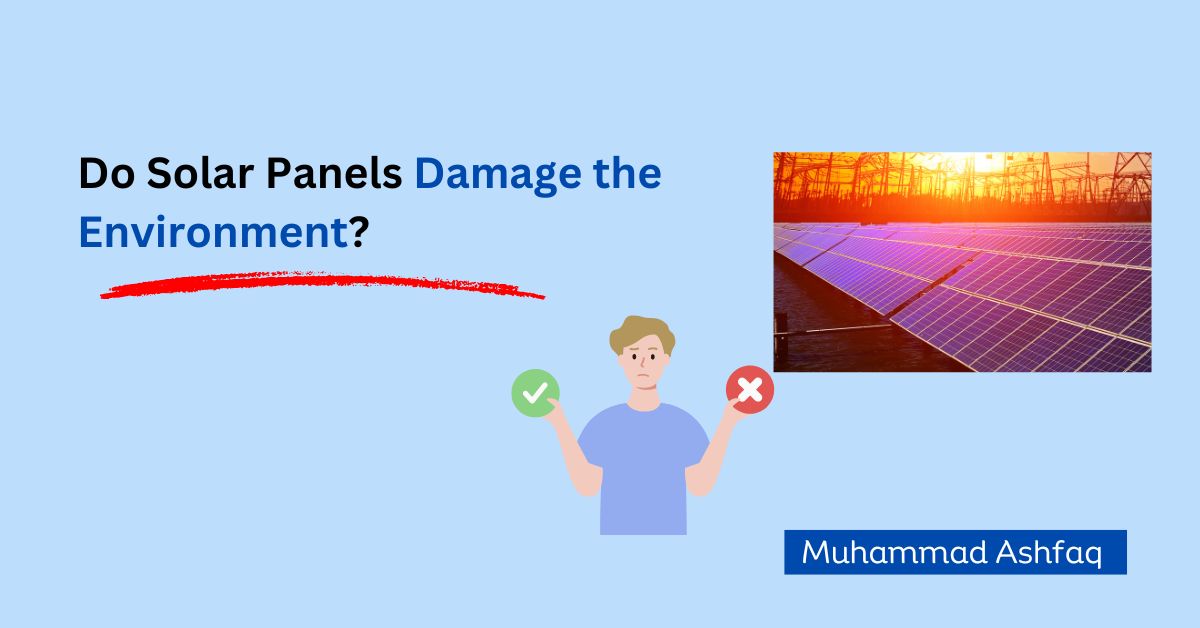Do solar panels have a negative impact on the environment?
Solar is not a trend but rather a necessity in 2024.
People are adopting it to reduce their reliance on the grid (unreliable) and contribute to the green energy transition.
But what if I ask You? Are solar panels really good for the environment?
Or, is there a negative effect of shiny panels installed on your roofs?
These questions require a bit of investigation.
So let’s explore that in detail.
The Environmental Impact of Solar Panel Manufacturing
At large solar energy is a clean process, but the manufacturing process of solar panels does have some environmental impacts.
Carbon Footprint of Solar Panel Production
A significant portion of polysilicon’s carbon footprint, ranging from 40 to 100 grams of CO2 per kilowatt-hour, is produced during its production.
80% of these emissions come from PV panel production processes in China (which dominated PV production).
Use of Hazardous Materials
The production of solar panels involves the use of toxic chemicals and heavy metals (like cadmium).
These may pose risks if not managed properly.
These hazardous materials can harm the environment if released during manufacturing or improper disposal of solar panels.
Energy and Water Consumption
I hope you don’t mind if I tell you that water and electricity are used during panel production (it’s obvious).
Solar panel manufacturing is an energy-intensive process, with electricity-related emissions accounting for 45% of the total GHG emissions.
If this electricity is generated from fossil fuels, it is considered non-renewable energy.
The manufacturing process also requires significant amounts of water (for cooling purposes).
This can test water resources in dry regions.
Land Use and Habitat Disruption
Of course, solar panels are great, but they require space. So they affect the biodiversity of the region.
This is not an issue in rooftop solar installation, but it definitely poses a serious concern in the case of utility-scale solar installation.
Do Solar Panels Increase Temperature?
I consider this question to be a “solar pandemic” in people’s minds.
Because whenever something new emerges, it tends to be surrounded by various queries within our society.
Let’s clarify it.
When you put PVs on that white roof, the panels typically absorb 90% of the sun’s energy.
And the panels convert about 20% of this energy into useful electricity.
What about the remaining sun’s energy?
It gets reflected in the environment, resulting in a warming up.
You end up with two hot surfaces: the top surface of the panels and the bottom side of the panels. As air flows over these panels, it readily picks up that heat essentially twice as effectively as if the panels were not there.
This phenomenon is known as the Photovoltaic Heat Island (PVHI) effect.
However, some sources do not agree with these claims. I hope a practical demonstration of this effect in the future will clarify things.
We just focus on the fact that solar benefits outweigh its challenges.
Do Solar Panels Cause Global Warming
While solar panels may have localized effects on temperature, their impact on a global scale is negligible.
The Solar gurus acknowledged that solar energy’s effects cannot be global because it only covers a small fraction of the Earth’s surface.
It would take a very large number of solar farms to significantly impact the climate.
Also, greenhouse gases are the main source of global warming.
As far as it is concerned, solar energy produces negligible greenhouse gases compared to fossil fuels.
Comparison with Other Energy Sources
When we talk about solar energy, its pros and cons should be compared with fossil fuels (the real enemy of the atmosphere).
Let’s examine them one by one.
Greenhouse Gas Emissions
Solar panels produce no greenhouse gas emissions during operation, compared to other sources of electricity.
Here is a comparison:

You saw that the combustion of fossil fuels releases huge amounts of carbon dioxide, which is a major contributor to climate change.
Air and Water Pollution
Solar power systems do not produce air pollutants during operation. They also use significantly less water compared to fossil fuel extraction and processing.
The smoke coming from coal power plants contains not only CO2 but also sulfur, which is detrimental to the lungs.
Although an electrostatic precipitator is necessary for each plant (which absorbs sulfur), you know how things work in practice.
Land Use and Ecosystem Impact
Solar installations are often placed on rooftops or in not-in-use areas, minimizing their impact on natural habitats.
However, the extraction of fossil fuels often results in habitat loss (due to water pollution).
On the flip side, fossil fuel power plants require a vast land (that is often cultivated) near rivers or canals.
It is a total waste of precious resources.
How Does Recycling Solar Cell Impact the Environment?
Solar panels contain valuable materials such as silicon, silver, copper, and aluminum.
About 75% of the weight of solar panels can be recycled.
As the global PV capacity grows, it is estimated that by 2030, more than 8 million metric tons of solar panels will need to be managed.
But without an environmentally friendly recycling process, the gains we’re achieving from solar energy will be reversed.
As:
- Many solar panels contain hazardous materials, like lead and cadmium.
- If not properly disposed of or recycled, these can seep into soil and water
How Recycling Produces Emissions?
Look at this astonishing figure: Recycling 1,000 kg of silicon photovoltaic waste produces approximately 446 kg of CO2 equivalent emissions.
These emissions primarily come from:
- Transport: Emissions from moving panels to recycling facilities.
- Processing: Emissions generated during mechanical separation, thermal treatment, and chemical processing of materials.
- Incineration: Burning plastic components of the panels can also contribute to emissions.
Researchers at Arizona State University are developing a new recycling process that utilizes chemicals to efficiently extract silver and silicon from solar panels.
This project is funded by the Department of Energy (USA), so we can hope a fruitful outcome will appear in the near future.
Final Thoughts
So, in our exploration, we thoroughly compared fossil fuels and solar energy side by side to obtain a balanced picture.
And it is clearly evident that solar panels are a safe and environmentally friendly partner to combat global warming.
From now on, if someone claims that solar panels are unsuitable for the environment, you can better address their concerns.
Frequently Asked Questions
Solar panels themselves do not produce any greenhouse gas emissions during operation. However, emissions are generated during the manufacturing process, in the production of polysilicon.
The production of solar panels involves the use of toxic chemicals and heavy metals like cadmium, which pose risks if not managed properly.
Large-scale solar power plants can require significant land areas, which can destroy habitats and reduce biodiversity.
While solar panels contain valuable materials like silicon, silver, and aluminum, there is currently a lack of efficient recycling systems for solar panels.
Solar batteries positively impact the environment by reducing greenhouse gas emissions and enhancing the reliability of renewable energy sources. However, they pose some challenges during manufacturing (that are negligible).

Content Writer | Assistant Manager (Electrical) at IESCO
As a passionate content writer, I’m on a mission to make solar hassle-free for you through my expert guides and easy-to-digest content.

